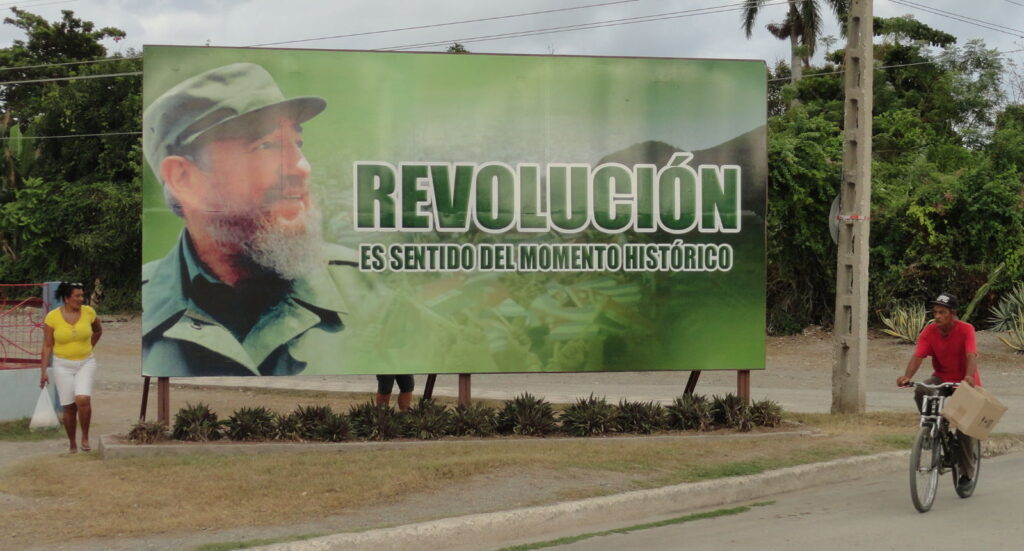(This was my column on Cuba for Cycling Plus magazine issue 304, September 2015. You can also read the blog of my End to End ride here.)
Cuba’s changing. Will it stay a ‘cycling paradise’? Rob Ainsley wonders…

Ah, Cuba. Loud percussive rhythms, aromatic distilled liquids, fragrant smoke. No, not salsa, rum or cigars: I’m talking about the clanking 1950s limos, smelling of petrol, and belching out such fumes they’d instantly fail an emissions test in the UK. From there.

I’ve just cycled it end-to-end – 1200 miles in four weeks, east to west. The prevailing wind was behind me almost all the way. As were the touts, shouting ¡Hey amigo! ¿Buy cigar?
It’s not all brochure-cover landscape. Sure, the remote south-coast road way out east – mostly impassable for cars due to hurricane damage, but easily bikeable – is amazing. And the tobacco-farm valleys and mountains round Viñales, out west, make for beautiful trundling. But the endless mid-island plains are about as thrilling as Lincolnshire: Spalding with sugar-cane.
You don’t come to Cuba for the scenery, though. It’s for the unique cycling experience, the 1950s timewarp, the car-free roads. It’s curious being stuck behind a horse and cart, for instance. Especially on a motorway.

Time stands still here. Particularly when you’re waiting to be served. You hear historic sounds long gone from our world: horses’ hooves on cobblestones; the dawn shouts of the bread-seller on his bike; the wheezing of dialup modems.

For most, bikes are the only option of getting around, given the awful infrastructure. (Town-to-town ‘buses’ are adapted cattle trucks. Trains take bikes, but you’re faster riding.) So cyclists are everywhere, on $30 make-do-and-mend machines: extended kids’ bikes; clanky Chinese MTBs; prewar ladies’ Raleighs; repurposed BMXs. Multi-occupancy is common – whole families on one machine, like Chinese circus turns. Extravagant loads too: sacks of potatoes across the handlebars, microwave ovens, ladders.
There are zillions of bike taxis. The usual model has three car tyres, the driver up front by the steering wheel, and two seats behind. One-passenger models are made from welding a wheelchair to the side of a bike. (Cubans can fix anything and are great improvisers. As the ubiquitous salsa bands show. Loudly. In next door’s flat, during your early night.)
On-the-go refreshment’s easy. Roadside stalls have tasty chilled fresh cane-sugar juice for 6p. You cycled past the fields where men macheted the crop down; got cut up by the lorry transporting it; watched the stallholder feeding the canes into a press with alarmingly exposed machinery; saw the juice come out; drank it.


Cuba is life with the lid off. You see the whole process, the cogs and wheels, how everything works. Like bikes. The streets are where stuff happens, love and food and music. Houses have doors and windows open, so you see daily life going on.
All this plus easy accomm and lively, friendly, warm people. With public spaces not ruled by motor vehicles but people-power, in every sense, the atmosphere is open, inclusive, safe, pleasant. Even dogs are laid-back: no barking wheel-chasers. No wonder people rate the place for cycling.

But Cuba is changing. Privatisation, liberalisation, Americans, Spanish football on telly… they’re here already. Change will be slower than most hope/fear, but already the cracks are showing. And I don’t just mean on the newly-trafficked roads.
The great metric of that change will be the rise in motor vehicles. They say Cuban drivers respect bikes, though the cut-up rate seems similar to Britain; few motorists simply means encounters are rare. But as the tarmac fills up with new drivers, those idyllic roads are getting busier.
In the 1960s, Britain’s public spaces sold their soul to the car as the post-austerity economy boomed. We lost something socially precious that utility cycling was part of. Despite the best efforts of the dedicated minority (Sustrans et al), we’ve struggled for paltry regains.

Which way will Cuba go? Towards Miami, banning horses and bikes from main roads, stopping kids playing in the street, making roadside stalls into drive-in Wendys? Towards Europe, with Dutch-style bike segregation?
I doubt it. They’ll find their own way, as usual. I hope one that shows that economic development can still preserve a social cycling culture. Perhaps they can show us where we went wrong, what we could do next. I’ll come back in twenty years to see. Maybe the queue for the internet cafe will have moved a bit by then.